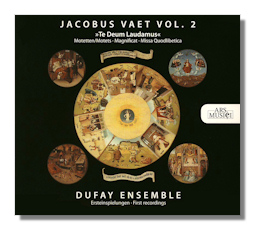
The Internet's Premier Classical Music Source
Related Links
- Vaet Reviews
- Latest Reviews
- More Reviews
-
By Composer
-
Collections
DVD & Blu-ray
Books
Concert Reviews
Articles/Interviews
Software
Audio
Search Amazon
Recommended Links
Site News
 CD Review
CD Review
Jacobus Vaet

Volume 2 - Te Deum Laudamus
- Te Deum
- Motet "Quoties diem"
- Motet "Ut queant laxis"
- Motet "In tenebris"
- Magnificat secundi toni
- Missa quodlibetica
Dufay Ensemble/Eckehard Kiem
Ars Musici 232392
This is the welcome second volume in a series devoted to the neglected Franco-Flemish composer, Jacobus Vaet (c.1529-1567). A handful of substantial sacred choral works lasting nearly an hour is sung here by the Dufay Ensemble, an eight-strong all-male group founded in 1990 at the Freiburg College of Music in Germany by Eckehard Kiem. The originality and beauty of the Te Deum, Quoties diem, Ut queant laxis, In tenebris, Magnificat secundi toni, and Missa quodembetica as well as the competent and stylish singing by the Ensemble only serve at the very least to intrigue us… What sort of composer was Vaet? Why isn't he better known? Or, better, to stimulate anyone fond of the sumptuous choral polyphony at the end of the Renaissance to collect as much of Vaet's music as they can. Which won't be much at the moment: next to nothing else is available. That so unassuming a group of singers yet one which is clearly well suited to Vaet's idiom is undertaking this survey (it's not clear how many CDs it will comprise) is all to the good.
"Sumptuous" is a word conventionally applied to the richly-textured, multi-layered music of choral polyphony of the fifteenth and sixteenth centuries. It implies a veritable "barrage" of sound, echoing throughout the basilicas of Europe. In the Dufay Ensemble's conception this emphasis on sonic impact is not a priority. Rather, the delicacy and pointedness of the texts. Every word is clear in the half dozen pieces which they perform here – even though the Te Deum and Magnificat are typically large scale, demonstrative, works. As you finish listening to this CD with its resonant acoustic, you will be left with a great sense of satisfaction. The Dufay Ensemble has emphasized expressivity and resolution over effect; and done Vaet a great service as a result.
The Te Deum is probably a late work. It's likely that its composition – something of a structural tour de force – was influenced by the practices at Venice, with which Vaet was familiar. Lacking the antiphonal brilliance common in such music from that city at that time, the work still makes use of complex and colorful divisions across the eight voices. The four-part motet, Quoties diem is much thinner, more restrained – severe, almost. It provides a good contrast, illustrating the range of Vaet's command of forms. Ut queant laxis is somewhat typical of Vaet's other hymns with contrasting homophonic and polyphonic styles. Similar varieties, particularly of tempo, are evident in this and the six-part motet, In tenebris, where chromatic writing is also emphasized. A delightful work with a great deal in a short time (barely three minutes).
The Magnificat secundi toni, and Missa quodembetica are both more substantial works in import; although the former lasts under ten minutes. Again Vaet manages a complex and effective structure which serves the laudatory text perfectly. The Mass is heavily contrapuntal in style; this produces a dense polyphonic sound which the Dufay Ensemble presents with great lucidity. At the same time as navigating these complexities, the singers articulate the liturgical tenor with real verve. This is the high point of the CD and repays repeated listening for the freshness and directness of the singing style.
The booklet that comes with the CD contains useful background and all the texts in Latin and German only. Whether or not you own the first volume, this is an uplifting and pleasing hour of music. It's performed with individualism by the Dufay Ensemble. Their style is intimate, approachable and highly competent. They make excellent advocates for Vaet's music. This CD can be recommended for anyone at all interested in the composer and in late Renaissance polyphony. More please!
Copyright © 2010, Mark Sealey.





















